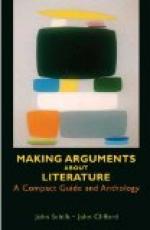The trigger of a crossbow has a releasing function: it removes the obstacle that holds the string, and lets the bow fly back to its natural shape. So when the hammer falls upon a detonating compound. By knocking out the inner molecular obstructions, it lets the constituent gases resume their normal bulk, and so permits the explosion to take place.
In the case of a colored glass, a prism, or a refracting lens, we have transmissive function. The energy of the light, no matter how produced, is by the glass sifted and limited in color, and by the lens or prism determined to a certain path and shape. Similarly, the keys of an organ have only a transmissive function. They open successively the various pipes and let the wind in the air chest escape in various ways. The voices of the various pipes are constituted by the columns of air trembling as they emerge. But the air is not engendered in the organ. The organ proper, as distinguished from its air chest, is only an apparatus for letting portions of It loose upon the world in these peculiarly limited shapes.
My thesis now is this: that, when we think of the law that thought is a function of the brain, we are not required to think of productive function only; we are entitled also to consider permissive or transmissive function. And this the ordinary psychophysiologist leaves out of account.[28]
The question of the validity of an analogy in reasoning is always, as here, whether the similarity on which the reasoning rests really runs between the two cases in hand, or is not merely a general resemblance expressed by some phrase or word which seems to mean more than it does. In other words, when you are testing an analogy, whether your own or an opponent’s, make sure that the similarity is real for the present case. A picturesque figure of speech may add life to an argument, but it may also cover a gap in the reasoning.
36. Reasoning by Classification or Generalization. Obviously the strength of reasoning from analogy increases with the number of cases which you can point to as showing the similarity on which you rely, for you can then begin to generalize and classify.
Analogy expresses our natural tendency to assimilate the new to the old, to interpret what is strange and unfamiliar in the light of what we already know. It may therefore be described as classification in the making. The resemblances which guide us are called analogies so long as they are newly seen, rare, or doubtful; but as the number of cases increases, analogy passes by insensible stages into established classification.[29]
An excellent example of this transition may be seen in the present state of the argument in favor of commission government: at first, as we have seen, it depended chiefly on reasoning from analogy; by this time enough cities have adopted the plan to make it possible to classify them, and so reason by generalization.




